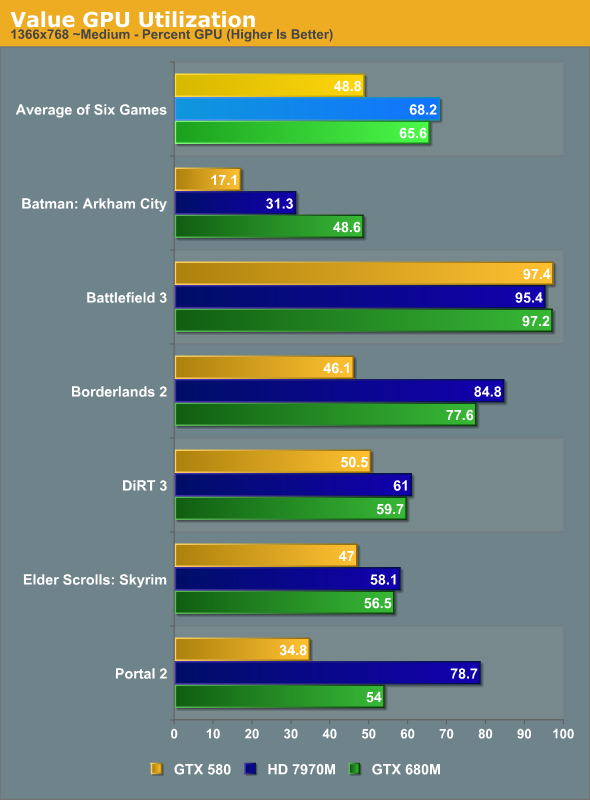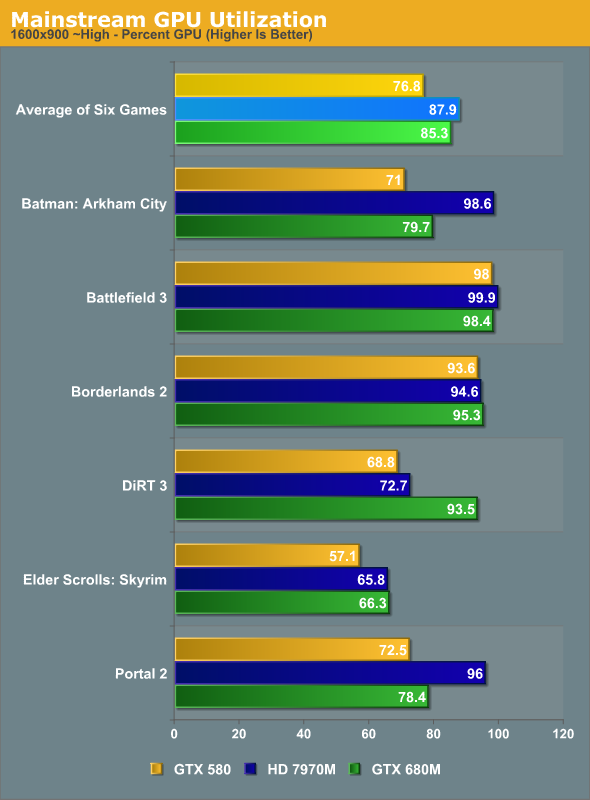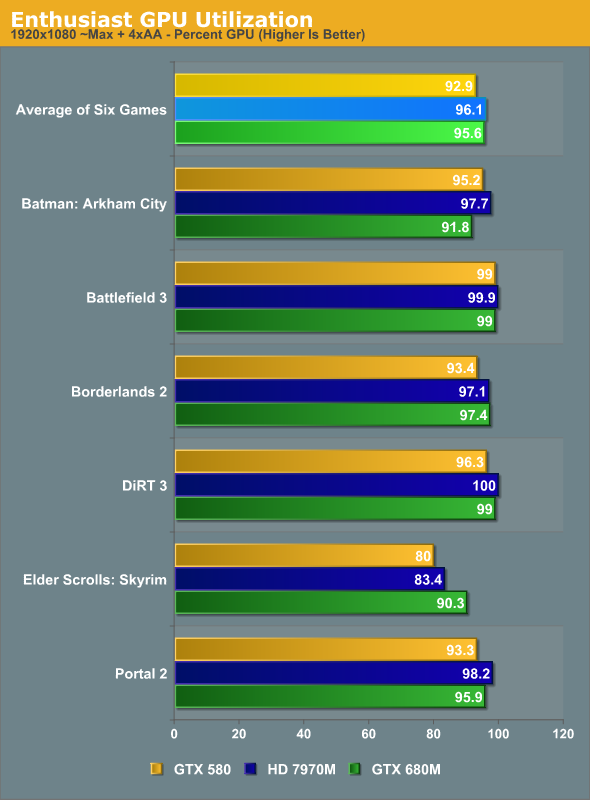AVADirect Clevo P170EM Part 2: GTX 680M Grudge Match
by Jarred Walton on October 15, 2012 6:50 PM ESTGPU Utilization Investigations
One of the issues we experienced with the initial drivers on the Radeon HD 7970M was lower than expected performance, and many users/owners of the 7970M Clevo notebooks have pointed towards GPU utilization as being the culprit. That seemed a bit odd when I first heard about the topic, as low GPU utilization should be a symptom of lower than expected performance rather than the cause—basically, if the GPU is capable of running at 150 FPS at certain settings but it’s only running at 75 FPS, you’d expect the GPU use to be around 50%. With the initial P170EM review, I did some quick checking on GPU utilization and found that, yes, it seemed low. With the Hotfix driver (which still hasn’t reached the public, though we’re hearing “this week”—meaning, some time during October 15-19), we also noted that GPU utilization did improve. Nevertheless, GPU utilization isn’t “always 90% or more”, which is what some people have been asking for.
To investigate this issue more thoroughly, I tested GPU utilization across our three benchmark settings in six of the games. For these tests, I’m not using built-in benchmarks or even FRAPS runs; instead, I played the same segment of each game in a pattern that was as close to the same as possible, and I did this over a longer segment of the games: typically at least two minutes of gameplay, with a decent amount of “action” as appropriate.
After testing the P170EM with both HD 7970M and GTX 680M, I noticed that GPU use was relatively consistent but still occasionally low. At that point it seemed that Enduro and Optimus might be the cause of lower than expected GPU utilization. The other possibility of course is that the CPU and other areas were the bottleneck and that the GPU simply wasn’t able to get enough data to work on quickly enough. To test whether Optimus/Enduro might be causing issues, I added my own gaming desktop system into the mix; it has an i7-965X clocked at 3.65GHz, 12GB (6x2GB) DDR3-1333 RAM, and a GeForce GTX 580 GPU. I ran the same gaming tests on all three systems, and here are the results:



Not surprisingly, GPU use is lower by far at the Value settings—1366x768 and ~Medium detail isn’t likely to tax the GPUs all that much, and the desktop system (with a faster GPU but potentially slower CPU) ends up with the lowest overall GPU utilization. The Mainstream testing pushes the GPUs quite a bit more, while at our Enthusiast settings most of the games are hitting 95% or higher GPU use. Looking at the games individually, we also notice that games that are typically more dependent on CPU performance (e.g. Skyrim), or at least not as demanding graphically (e.g. Portal 2), have lower GPU utilization.
I didn’t run a full set of tests using the earlier AMD 7970M drivers, but I can tell you that the Value and Mainstream results would be much lower, and even the Enthusiast settings are probably in the low 90s or high 80s on average. With the Hotfix driver installed, however, AMD’s 7970M ends up being the “best” overall at achieving high GPU utilization. I’m not sure that really matters all that much, as the real story is gaming performance. Whether low GPU utilization causes low frame rates or the low frame rates reduce GPU utilization, either way the fix is generally going to involve reworking the graphics drivers.










58 Comments
View All Comments
Zodiark1593 - Monday, October 15, 2012 - link
Think we can get a comparison of the GTX 680M SLI vs the Radeon 7970M Crossfire?Also, do Clevo laptops that come equipped with dual GPUs also rely on a muxless design?
sabot00 - Monday, October 15, 2012 - link
"That’s a cost increase of 15% for a typical gaming performance increase of around 20% at high quality settings"I disagree with this reasoning, as a laptop also does many other things, many of which (CPU, HDD, RAM, internet performance) don't increase with the price.
This is analogous to saying that one can purchase a 256GB 830 SSD for $160, which is only around a $40 premium over a 1TB laptop HDD. Then claiming that this new laptop has 600% more performance in random 4K reads for only a $40 (2% increase for a $2000 laptop) premium.
While important to many people, especially buyers of these laptops, it's ultimately up to the buyer to decide, and as such, the premium for a purely graphical upgrade should not be weighed against the total cost of the laptop.
The 7970M is ~$450, in terms of OEM price, the GTX 680M is $650, truly, it is a 44% percent increase in price of the graphics subsystem for a 20% increase in graphics performance.
JarredWalton - Monday, October 15, 2012 - link
I'm speaking to people shopping for a gaming notebook. Since you generally can't purchase just a GPU upgrade (you can try, and in some cases it might even work -- some older Clevo units at least have managed to run multiple generations of GPU hardware), you have to buy the whole package. Yes, it's 40% more for 20% more performance when just looking at the GPU, but unlike desktops you can't just look at the GPU upgrade cost. Also, anyone buying HDDs without an SSD for the OS/apps just doesn't know what it's like to have a system boot and load apps quickly. Once you go SSD, you'd definitely pay double the price for one fourth the capacity and count yourself lucky.krumme - Tuesday, October 16, 2012 - link
Going by your logic, every gamer should buy a faster gfx for their rig. As total cost always will make the faster gfx a better choice. When does it end?You can explain all you want, but your reasoning stands as one of they most idiotic this year, and makes this look like a commercial.
Man even Nvidia nor AMD would ever come up with such an argument.
Think about applying this logic to rest of your purchases. Damn.
cjb110 - Tuesday, October 16, 2012 - link
I think if your looking at laptop gaming then yes the logic of buying the fastest gfx is sound. Laptops still have more of a mismatch between the capability of the cpu and the gpu. i.e. the CPU isn't the bottleneck.I don't think any one at AnandTech would apply the same logic to desktop gaming. In desktops its more even, so making sure the two are matched will save you money.
krumme - Tuesday, October 16, 2012 - link
No ssd, 768 15 pathetic screen, lousy build quality?274 usd brings you a long way of improving your rig.
Its the first time i hear the argument in 20 years on the www, and for a good reason.
JarredWalton - Tuesday, October 16, 2012 - link
No, it's not the first time the argument has been made. We frequently discuss the value of upgrading to a faster GPU in our desktop GPU reviews. If you look at an HD 7770 GPU that costs $125 and compare that to a 7870 at $240, is there value in the upgrade? Yes: it's substantially faster (nearly twice as fast), which opens up the possibility for 1080p gaming in most titles. Then we look at the HD 7970 and it's $410 but is only 20-30% faster. It's no longer a stellar upgrade.Here, we're looking at the total cost with gaming as the main purpose for buying a gaming laptop. It's okay to think people buying gaming laptops have more dollars than sense, but assuming someone wants a high performance gaming laptop, they're going to be shelling out minimum $1800 for something with HD 7970M or GTX 680M. So, if you have to pay $200 more to swap out AMD for NVIDIA hardware, is there value there?
The answer is a resounding yes. Sure, the 20% performance increase is nice, but it's about more than the performance. I specifically note the driver situation (twice in the conclusion alone). Given the option between Enduro and Optimus, right now you're shooting your gaming laptop in the foot if you go with Enduro. AMD has to fix this, and I think they will fix things, but that doesn't change the fact that they've been selling 7970M for four or five months with a major lack of driver support. Talk to me in another month, and hopefully I can say that it's no longer a major sticking point, but today? Nope, AMD's solution is hamstrung.
krumme - Wednesday, October 17, 2012 - link
The argument about driver and the quality of optimus is completely valid in my world. I have good experience with the optimus gaming laptop i have, and would always favor stability. Enduro is not working yet. Its very simple for my personal preference.But when buying a rig, you are always torn between where to put your money.
Do you prefer a gaming rig with an ssd and better screen to a faster gfx? - its not up to the reviewer to be the judge here. And present it as the truth. The reviewer can present the facts, and then the consumer, can make the right choises based on his own needs. The reviewer should be the guide.
JarredWalton - Wednesday, October 17, 2012 - link
You're reading a review, which inherently has subjective opinion -- a full page of it earlier, obviously, but the conclusion has a lot of subjective stuff as well. It actually *is* a reviewers job to be a judge; otherwise I should just run the benchmarks and post graphs and I could be done with a review in a day or two rather than spending a couple weeks running and evaluating. It's not a laptop review if all you're doing is showing performance and the price. You need to evaluate how the whole package comes together.People can certainly disagree with me and say, "I don't personally need or want to spend the money for an SSD." Or, "I think the 7970M is the better graphics card [because...]" That's fine. But my opinion is that when looking at the cost to buy a well equipped P170EM for gaming purposes, the additional money required to go from 7970M to 680M is definitely the way to go. If the extra $275 at AVADirect for that particular upgrade is "too much", you should NOT be buying a gaming notebook that costs $1500+ in the first place.
krumme - Wednesday, October 17, 2012 - link
The recommendation of the more expensive alternative is wrapped in numbers, presenting it as objective fact.When what happens is comparing total cost to a single benefit, albeit the most important one. Its inconsistent, and presented the wrong way imho. Its very simple just to say its say 15-20% faster, then the buyers can make up for themselves.